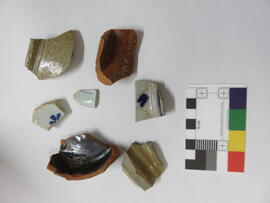Two boxes of animal bone were assessed. The material covers both phases of the site's occupation, the Nunnery Phase and the College Phase, and the main aim of the evaluation was to judge whether differences in living standards could be determined from the bone fragments.
The Nunnery-phased material consists of approximately 3 kilograms of animal bone while that of the College Phase is substantially more (9 kg). It should be noted that 1.5 kilograms of the Nunnery assemblage consists of the partial skeletons of a young pig and her three piglets (foetal). In general, the preservation was reasonable, and recovery techniques had permitted the retrieval of some very small fragments of bone including bird, fish and rat remains. Dog gnawing was observed on a minimal amount of bone.
The identifiable fraction of the Nunnery bone is 70 fragments and that of the College Phase, 683. However, the small nature of the Nunnery assemblage precludes further in-depth analysis, indeed many of the fragments belonged to oxo (large mammal, cow/horse/red deer) and sma (medium-sized mammal, sheep/goat/roe deer pig/) categories.
The partial pig skeleton had not reached two years of age and her three piglets were all foetal.
Showing that both meat-bearing (crudely denoted by bold type) and non-meat-bearing bone occurs for cattle, sheep/goat and pig, it would appear that live animals were brought in or kept at the College, and slaughtered on site.
Since pig bones, by virtue of their shape, can be recognised from very small fragments, it is highly likely that the sma component of the assemblage is sheep/goat and it is very noticeable that this taxa is much more fragmented than the cattle bones. The oxo fraction is most likely reflecting cattle, since horse and red deer were only represented by one metapodial fragment and two metatarsal bones respectively. This aspect would repay further study in conjunction with an in depth analysis of the butchery marks. Incidentally, several cattle and sheep /goat vertebrae had been split sagittally and also a sheep cranium had been cleaved in half in order to extract the brains.
While further analysis would establish the relative importance of the main domesticates, the impression gained from this evaluation is that mutton formed an important part of the college diet together with beef, with some contribution of pork and variation in the diet being provided by duck, wood pigeon, chicken, goose, red deer and fish, with perhaps the occasional rabbit or hare.
Both the Nunnery and College animal bone assemblages are unique in the archaeological record. Unfortunately, the Nunnery sample is too small to be useful at the analytical stage. However, the quality of such material has been established b y the excavation, a n d it is recommended that at the earliest opportunity, n o time should b e lost obtaining further samples.
The College Phase assemblage is also important because very few post-Medieval assemblages have been analysed and published. The material is very well preserved and, as stated above, an analysis of the butchery is desirable. It would be advisable to undertake this in conjunction with other assemblages of similar date, which are i n the same geographical area.
Some 97 pieces of metalwork, weighing 2084g, were recovered during excavation at Jesus College as part of the refurbishment programme of Chapel Court, and include respectively eight each copper alloy and lead objects, the remainder consisting of iron. Only diagnostic items are described below, the vast majority of the ironwork being undiagnostic and all in a poorly
preserved condition.
This small assemblage from Chapel Court is largely unremarkable, fragmentary and undiagnostic. That a significant proportion of the assemblage was recovered from disturbed and unstratified contexts also attests to the degree of local disturbance that would be expected from a building that has witnessed prolonged use and modifications. Despite the seemingly poor quality of the assemblage, however, two pieces of metalwork stand out. These are the lead stylus and Boy Bishop token. Both associated with religious foundations, the former attests to the degree and type of literacy within the former nunnery of St Rhadegund’s and the latter to celebrations either associated with Christmas or to quasi-commercial activity that took place during the annual fair held at the site (this fair subsequently became Garlic Fair, persisting into the 19th century). The date of these two items suggests they were connected to the nunnery, a view strengthened by the general location where they were found. As such, these items, and the later metalwork objects, provide evidence of the changing nature of the use of the site and of activities that took place within the courtyard, witnessing the transition from a religious foundation to the present day college.
A significant, although poorly stratified, assemblage of clay tobacco pipes (MNI 50) was recovered. The assemblage is predominantly 17th to 18th century in date, although at least one 19th century fragment is present. The assemblage is notable for the presence of six pipes with the initials IK; these were produced by James Kuquit of Cambridge who was active c.1713-50. Two of these have a stamped mark of a crown in relief, on the base of the heel; this particular combination has not been recognised previously. The presence of clay tobacco pipe in a context indicates a date of. c.1580+. Bowls have been categorised using the Oswald general typology (1975). Information on makers derives largely from Cessford (2001), although subsequent unpublished research has modified some of the identification and dating of manufacturers.


































